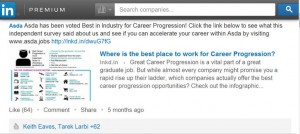The common perception is that LinkedIn is for B2B companies, while B2C marketers are better off on Facebook, Pinterest or Twitter.
Reality is somewhat different! According to a 2013 survey, 51% of B2C companies use LinkedIn as a marketing platform (far more than the 35% who use Pinterest). The figure in the US is even higher according to the Content Marketing Institute, at 71%, but nearly half were not sure that it was effective.
So how can B2C marketers use LinkedIn strategically?
Reach consumers directly. First of all, it’s worth remembering that even if your company is supplying to consumers, many of them will be present on LinkedIn. Nowadays a large percentage of the workforce belong to the site, and just because they are there in ‘business mode’ does not necessarily mean that they cannot be reached as ‘private citizens’ as well.
This is particularly true if you are trying to market your product or services to professionals, for example a clothing company selling business suits, or a career advisor helping executives shift to new fields or examine new opportunities. LinkedIn would be just as natural for you as Facebook!
Or perhaps you are selling high-end products such as computers, mobile phones or cars. Not only will these products be of natural interest to the relatively wealthy LinkedIn demographic, they can be marketed as helping individuals be more successful in their personal and professional lives.
So do not automatically dismiss LinkedIn – consider carefully whether it could work for your business.
Find referrers / strategic partnerships. Even if you are marketing directly to consumers, your business may still need to work in partnership with other businesses to grow.
Many businesses, for example, rely on referrers to direct the right kind of clients to them. If you are a counsellor specialising in people who have just gone through a divorce, you might want to meet divorce lawyers who can send their clients your way. Or if you are a gardener, you might want to meet companies specialising in outdoor lighting, or real-estate agents, or any number of other businesses who might have clients who need your services.
Perhaps you can even develop a strategic partnership, running a webinar or writing a blog together with tips on how to make your garden look its best – potentially benefiting both businesses.
LinkedIn is the natural place to build and cultivate relationships with these key influencers, who can provide you with access to new prospects. Future clients will highly value any form of third-party endorsement: it acts as a form of quality assurance for your products and services.
Find suppliers. You might not be able to sell to individuals on LinkedIn, but you might want to be sold to. LinkedIn is a great place to find suppliers for your own business.
Find staff. LinkedIn is built for companies searching for new talent, so why wouldn’t you take advantage? Not only can you advertise positions on your company page, you can actively head-hunt through thousands of potential employees with LinkedIn’s advance search function.
Many B2C companies use LinkedIn to make themselves attractive to potential employees. Supermarket Asda’s company page, for example – which is followed by over 35,000 people – is a mixture of job advertisements and updates celebrating its working culture.
Many larger companies have invested in a careers tab, which allows them to promote job openings in a more systematic way, as well as to share testimonials from their staff about why they like working there, and more detailed information about the opportunities available.
Johnson & Johnson, for example, regularly shares videos and quotes from its team:
Reach Shareholders. Comparing Coca Cola’s Facebook page and its LinkedIn company page is instructive. On Facebook, it is very much focused on reaching consumers with posts about the upcoming 2014 FIFA football World Cup football, which it is sponsoring. The emphasis is on popular interest and emotion.
On LinkedIn, Coca Cola is far more focused on company news, much of which is clearly directed at shareholders.
Raise your profile in your industry. By being active on LinkedIn, particularly in LinkedIn groups, and by sharing valuable content with your contacts, you can become known as an expert in your industry. Inevitably, over time, this will make you a more desirable business partner, speaker and employer.
It can also be brilliant PR, bringing you to the attention of journalists who are always looking for experts in relevant industries that they can rely on for a great quote.
Market Intelligence. Use LinkedIn groups to learn, in real-time, what others in your industry are discussing, worried about and developing. Use them as a resource for your own queries.
And of course, keep an eye on your competitors in LinkedIn, to see who they are hiring and firing, what products and services they are promoting, and how they seem to be developing.
In many ways, then, B2C use of LinkedIn is not so different to the way B2B uses it. Many companies will be able to use the same kind of systematic lead-generation campaigns, targeting individuals or potential business partners; take exactly the same advantage of LinkedIn’s database of potential employees; and benefit from LinkedIn groups.
The key is to understand that you mostly should not share the same material on LinkedIn that you do on Facebook. You will have a different target audience and should develop a separate strategy. Be aware of the context in which you are working and use it accordingly. But just because you are B2C, do not automatically dismiss LinkedIn!
Are you a B2C marketer who regularly uses LinkedIn? I’d love to hear about your own experiences, tips and advice on how B2C companies can benefit from the platform.








